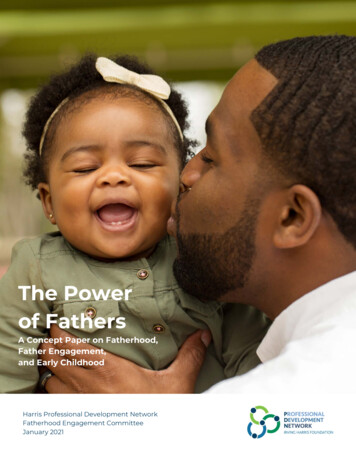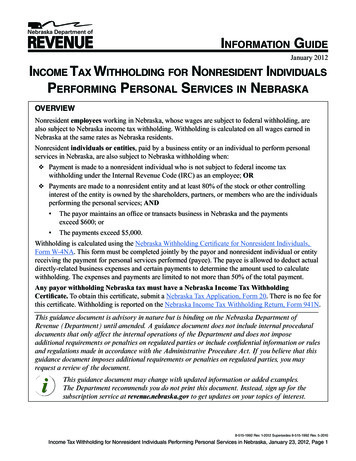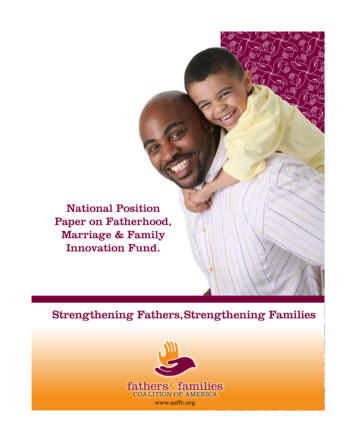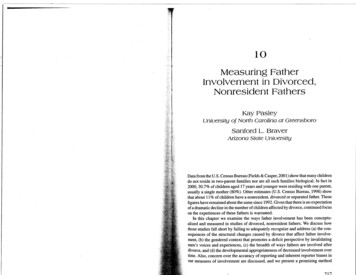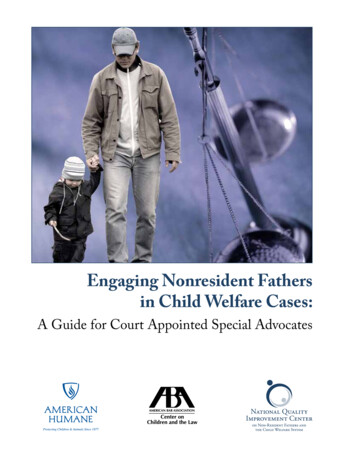
Transcription
Engaging Nonresident Fathersin Child Welfare Cases:A Guide for Court Appointed Special Advocates
Engaging Nonresident Fathersin Child Welfare Cases:A Guide for Court Appointed Special AdvocatesJessica R. Kendall and Lisa PilnikEdited by Claire S. Chiamulera3
This publication was produced by the National Quality Improvement Center on Non-Resident Fathers and theChild Welfare System (QIC NRF), funded by the Children’s Bureau of the U.S. Department of Health and HumanServices. We are grateful to our Project Officer, Jason Bohn, and to our QIC NRF project partners, the AmericanHumane Association and the National Fatherhood Initiative, for their support and thoughtful feedback on ourdraft manuscripts.We also want to thank National CASA, and Sally Erny in particular, for supporting this brief and carefullyreviewing it and providing useful input. Special thanks also go to Darlene Ward, program manager of the NewYork state CASA Program; Christina Tisserat, program manager of the Lincoln County Colorado CASA AdvocatesProgram, and Linda Katz, program manager of the Seattle, Washington CASA. Each thoughtfully reviewed the briefand provided important feedback and support.Howard Davidson, the ABA Center on Children and the Law’s director, and Richard Cozzola and Mark Kiselica,members of the National Advisory Board for the QIC NRF, reviewed drafts of this publication and shared valuablesuggestions.Thank you also to Claire Chiamulera for meticulously editing the manuscript and coordinating its design andprinting.Finally, nearly 100 young people now or formerly in foster care shared their thoughts and feelings about their ownfathers with us. Many of their words are included in this document, and all of their contributions informed thispublication and our work on this issue. We are grateful to the youth who shared their stories with us, and to thestaff at their organizations who helped gather their input: Justin Lee from the Pennsylvania Youth Advisory Board,Kara Sanders from The Mockingbird Society in Washington, and Terri Bailey from Elevate to Inspire in Iowa.-Jessica R. Kendall and Lisa PilnikAmerican Bar Association Center on Children and the LawA bout this BriefThe National Quality Improvement Center on Non-Resident Fathers and the Child Welfare System (QIC NRF) isexamining the impact of nonresident father involvement on child welfare outcomes. Through research, it seeks tounderstand the relationship between children, nonresident fathers, and/or paternal relatives. Since its start, theQIC NRF has focused on developing materials for child welfare system players— judges, lawyers, social workers,fathers, and others—on the importance of father engagement. This publication extends what the QIC NRF haslearned to CASA volunteers and programs. A successful presentation at the annual National CASA conference in2009 led to developing this practice brief geared to CASA advocates. It offers another useful tool to advocate onbehalf of children.In addition to this brief, the QIC NRF has other resources that may be useful to CASA programs and volunteers,including: a book on advocating for fathers in child welfare court cases; a curriculum for attorneys on advocating for nonresident fathers; the father-friendly checkup for child welfare agencies; and newsletters on several topics, including child support, father engagement, and parent representation.View these and other publications and materials developed by the QIC NRF at: www.fatherhoodqic.org.Copyright 2010 American Bar Association and American Humane Association.This publication was made possible through a cooperative agreement between the U.S. Department of Health andHuman Services, Administration for Children and Families, Children’s Bureau, the American Humane Association,the American Bar Association Center on Children and the Law, and the National Fatherhood Initiative.The views expressed herein have not been approved by the House of Delegates or the Board of Governors of theAmerican Bar Association and, accordingly, should not be construed as representing the policy of the AmericanBar Association or the QIC NRF project partners.4
Introduction“While it may take extra effort to involve a nonresidential father, it isusually in the child’s best interest to do so.”— Children’s Bureau, U.S. Departmentof Health and Human Services1Each year, hundreds of thousands of children become involved with childprotective services (CPS) due to suspected or confirmed abuse or neglect.Some of these children were living with both biological parents when CPS gotinvolved, and their mother, father, or both, maltreated them. However, many ofthese children were living with their mother, mother’s partner, or other relatives,but not their father. For these children, their biological fathers are often left outof caregiver search efforts, case planning, team meetings, and court hearings,even if they were positively involved in the child’s life before CPS involvement.2Failing to engage noncustodial (“nonresident”) fathers in child welfare casesharms children by robbing them of many potential resources. Fathers andpaternal relatives may serve as placement resources, provide youth meaningfuladult connections, and provide financial, emotional, and other support.Support from noncustodial fathers may also help custodial mothers or othercaregivers address the issues that first brought the child to the attention ofCPS. In cases where the father does not want to be involved with a child, orcannot be a positive presence in the child’s life, determining and documentingthis throughout the case will also reduce delays in permanency once the casereaches the termination of parental rights or adoption stages.As a nonlawyer court appointed special advocate volunteer or a volunteerguardian ad litem (CASA volunteer*), your advocacy should include efforts toengage fathers in child welfare cases. Many of your child clients’ biologicalfathers may not live with them when CPS becomes involved with the family. Or,the father may not be accused of abuse or neglect when CPS intervenes.This guide offers you practice tips to identify and engage these fathers in yourchild clients’ cases. (If you are an attorney, a version of this brief for lawyers isavailable at www.fatherhoodqic.org.) Some of this material may also be usefulwhen working with noncustodial mothers or custodial fathers. The informationand tips below will help you make informed recommendations about children’sbest interests, and promote father engagement that supports those bestinterests.* Used in this brief to refer to CASAs and GALs.5
The Importance of Father Involvement“Having a male as part of your life is a big deal. There is just a connection thatfather and son have that cannot be replaced. [I think CASA volunteers should]try their best to make sure that there is a connection with son and father.”What FosterYouth SayA bout their FathersIn developing this brief,the QIC NRF worked withfoster youth empowermentgroups across the countryto learn what youth thinkabout their fathers and theirrelationships with them.We found that althoughthe youth’s feelings andinvolvement with theirfathers varied greatly, theimpact a father can have onhis child’s life, positive ornegative, is profound.Throughout this briefare the questions we asked,and responses from youthcurrently or formerly in fostercare and involved with thePennsylvania Youth AdvisoryBoard, The MockingbirdSociety (Washington State),or Elevate to Inspire (Iowa).– Foster youthImproves children’s quality of lifeAlthough most children from single-mother households grow up to livehealthy and productive lives, research shows youth from father-absent homesare more likely to experience poverty, emotional and behavioral problems,substance abuse, incarceration, and problems at school (e.g., repeating a grade,dropping out, poor performance).3 In contrast, having a closer relationshipwith their fathers is linked to higher self-esteem and lower depression rates inadolescents. Increased father involvement in activities such as family outings,homework, and meals is linked to better academic performance, more positivesocial behavior, and fewer behavioral issues in children and adolescents.4Studies of families involved with the child welfare system show: Involvement by nonresident fathers is associated with morereunifications and fewer adoptions. Higher levels of nonresident father involvement substantially lower thelikelihood of later maltreatment allegations. Highly involved nonresident fathers’ children exited foster care faster.5 Children who had had contact with a noncustodial parent in the last yearwere 46% less likely to enter foster care.6In addition to social science research, much anecdotal evidence shows thatyouth in foster care benefit from contact with their fathers; youth often revealthat they value their relationship with their fathers, or wish they had moreopportunities to get to know their fathers. As a CASA volunteer, you have likelyseen the difference it makes when noncustodial fathers are engaged in theircases and given the opportunity to be a resource for their children. Having thefather and his family involved with the child also means there are “more eyes onthe child,” which can increase safety and well-being.Provides children with adult connectionsYouth in foster care need adult connections. They need to know who theirparents are and to have as much contact with them as is possible and safe. Thisapplies to fathers just as much as mothers, particularly when the father did notabuse or neglect the child. If you have worked with a child who begs to returnto a parent who the courts have said cannot care for her, or who connects withhis biological family immediately after aging out of foster care, you understandthat kids don’t just want permanent parents or guardians; they often want theirparents.6Engaging Nonresident Fathers in Child Welfare Cases: A Guide for Court Appointed Special Advocates
Although many fathers struggle with inexperience as a parent, substance abuse,incarceration, or poverty, none of those things limits a father’s ability to lovehis child, or a child’s ability to feel loved and connected. Children in fostercare need that love and connection from their fathers, even when their fatherscannot be placement resources.Barriers to Father Engagement“I didn’t talk to my dad from the time I was 4-14. I lived with him for 6 monthswhile I was 14. Now we talk just about every day.”–Foster youthFailure to locate/contactA 2006 Urban Institute report found that although noncustodial fathers hadbeen identified in most cases studied, far fewer of the fathers were contacted bythe agency or visited their child.Almost 2,000 children removed fromhomes where the father did not reside88%Agency has identified the father55%Agency made contact with father30%Father has visited child28%Father expresses interest inchild living with himThe federal Child and Family Services Reviews (CFSRs) have also found manystates: do not adequately involve fathers in case planning or provide services forthem; fail to contact fathers, even when they had been involved in theirchildren’s lives; or do not adequately involve fathers in any aspect of their child’s case.To read your state’s CFSR report, visit http://basis.caliber.com/cwig/ws/cwmd/docs/cb web/SearchForm.Although there is sometimes a perception that noncustodial parents are“absent” entirely from their children’s lives, this is rarely true. A study of nearly4,000 families across the country who were involved with CPS found that in73% of the families where there was a noncustodial parent, that parent had hadcontact with the child(ren) in the last year.77
Failure by child welfare caseworkers and the courts to locate and contactfathers, even when their identity is known, prevents many fathers fromengaging in their child’s case or, in some situations, from even knowing thechild has been abused or neglected. In the Urban Institute report discussedabove, only 55% of noncustodial fathers were contacted, compared to 100% ofnoncustodial mothers. This disparity may have been due to: caseworker bias against men; fears that involving the father would lead to more work for an alreadyoverburdened caseworker; fears that the father could be violent; or a lack of due diligence in securing adequate contact information for thefathers.Caseworker bias is viewed as “the most widely researched barrier to fathers’participation in child welfare case planning.”8 In one study, “caseworkers werefound to require that fathers demonstrate their connection to the child whereasthe mothers’ connection was taken for granted.”9Mothers’ resistance to share informationMothers often act as “gatekeepers,” withholding information about the father’sidentity or location. In some cases, the mother does not want the father to beconsidered as a placement resource or included in decision making, while inothers she may be protecting that father from court involvement (e.g., if hehas immigration issues, large child support arrearages, or pending criminalmatters), or she may simply be ashamed that she is involved in an abuse orneglect proceeding and not want the father or his family to find out. Somemothers also shield their children from their fathers because of a history, on thefather’s part, of past child maltreatment, or violent or criminal behavior. Not allfathers have such histories, however.8Engaging Nonresident Fathers in Child Welfare Cases: A Guide for Court Appointed Special Advocates
A Framework for Involving Fathers in Children’s LivesDespite the potential for positive outcomes when fathers and paternal relativesare involved, roadblocks remain. Overcoming these roadblocks takes anorganized framework, such as the following from The National Center on Fathersand Families (NCOFF). It is based on practitioners’ experiences serving fathers,mothers, children, and families:1. Fathers care – even if that caring is not shown in conventional ways.2. Father presence matters – in terms of economic well-being, social support,and child development.3. Joblessness and unemployment are major barriers to family formation andfamily involvement.4. Systemic barriers – in existing approaches to public benefits, childsupport enforcement, and paternity establishment – create obstacles anddisincentives to father involvement.5. A growing number of young fathers and mothers need additional support(co-parenting) to develop the skills to share parenting responsibilities.6. Transitioning from the role of biological father to committed parentsignificantly affects the father’s own development.7. The behaviors of young parents, both fathers and mothers, are influencedsignificantly by intergenerational beliefs and practices within their familiesof origin.Source: Adapted and reprinted from Merkel-Holguin, Lisa. “Fathers and Their Families: TheUntapped Resource for Children Involved in the Child Welfare System.” Child Protection Leader,September 2003, published by American Humane.9
Fathers’ personal issuesFathers also face other barriers in their lives, including poverty, substanceabuse, incarceration, or language or literacy barriers: Poverty — These men are often extremely poor: 20% of nonresidentfathers are believed to have incomes below the poverty line.10 As a result,they may lack a fixed address or phone number where agency staff andCASA volunteers can reach them, and they may find it difficult to affordtransportation to meetings, visits, or court appearances.How has your dadbeen involved inyour life? Low literacy — Many fathers do not understand what is happening totheir child because they cannot read or understand notices sent to themby the agency or court, due to illiteracy or lack of fluency in English. Eventhose who can read and write in English may be intimidated or confusedby the unfamiliar legal or child welfare terms in letters or documents theyreceive.“He has been supportive of meand gave me advice when Ineeded it the most.”“He was always in my lifeuntil he went to prison.”“He hasn’t been in my life atall.” Substance abuse/Criminal history—Many struggle with current or pastsubstance abuse, or have been charged with misdemeanors or felonies inthe past and are afraid of becoming involved with the courts again.“My dad tried to get custodywhile we were in foster care.My father did not get custodyof us because he starteddrinking again. He called usas much as possible.” Incarceration—Incarcerated fathers are frequently left out of childwelfare cases. Like other nonresident fathers, they can contribute greatlyto their children’s lives.“My dad comes around whenhe wants something and tellsus he loves us and wants tosee us more, then leaves atrandom.”“He has been involved in myspiritual life by helping meget through the hard times.”“He is like my best friend! Heis so supportive.”“I don’t know my father.”“He has not really been a partof my life. He says he cares buthe doesn’t show it.” Uncertain parenting skills—Fathers who have not been primarycaregivers for children before may not feel confident about theirparenting skills. Unawareness of children/fatherhood—Fathers may be unaware thatthey have children or unsure they are the fathers of particular children.Each of these challenges can be overcome, however, by services the agencyshould be providing as part of its reasonable efforts requirements (such as aninterpreter, vocational training, or housing assistance).Practice Tips for CASA Volunteers“I think that once the state gets involved with children, fathers tend tostay away, so CASA volunteers or some other service providers shouldwork on keeping fathers involved with their kids.”“My dad has never really beena part of my life. I met himonce when I was 12.”“My dad calls me everySunday night and he sendsme money and I go visit him.”–Foster youthAs a CASA volunteer, you can ensure fathers engage in the child welfareprocess and with their children. You are charged with conducting your owninvestigation and making recommendations to the court about the child’sbest interests. You can interview and meet with the child’s father and paternalrelatives to assess their interest in and ability to participate in the child’s life.With fewer cases to manage than the child’s caseworker or attorney, you candevelop relationships with the child and relatives that other parties may not.Your child-centric focus may also be less intimidating to the father and hisfamily, making them more apt to work with you. Your role in encouraging apositive father-child relationship should begin early in the case and carrythrough permanency.10Engaging Nonresident Fathers in Child Welfare Cases: A Guide for Court Appointed Special Advocates
Help identify and locate the father.Often the agency and court only try to identify and locate missing fathers at thevery beginning and end of a case. Even if there was an earnest attempt to locatethe father early, new information may come to light as the case progresses thatmay make it easier to find him. You can encourage these ongoing efforts. Failingto make ongoing diligent efforts to locate the missing parent is not in the child’sbest interest: It prevents the child from maintaining or establishing an importantconnection with a parent. It may prevent the child from maintaining or establishing connectionswith paternal relatives. It deprives the child, court, and parties of important information aboutthe father’s and his relatives’ capacity to parent or be involved in thechild’s life. It may delay permanency for the child if adoption is the goal if the fatheris found late or not diligently searched for until the termination stage.You can help ensure the agency makes reasonable efforts to locate unknown ormissing fathers, and that the court fulfills its oversight responsibilities by takingthese steps: Remind the agency to continue efforts to find the father. Ask the judge to inquire about the father’s whereabouts at every review orstatus hearing. Ask the child (if age appropriate) whether she knows her father and wherehe may be. Ask the mother and other known relatives about the father’s whereabouts. Work with the child’s attorney (if there is one) to search for the missingfather and/or advocate in court verbally or by motion that search effortscontinue. Report your findings to the agency and court to help them locate themissing parent.Encourage the agency to find missing parents.Child welfare agencies use various tools to locate missing parents. You can askthe caseworker which avenues were explored and suggest she use new ones tolocate the parent, such as: Consult the state Department of Revenue or child support agency files. Hire a private investigator. Check the Federal Bureau of Prisons and any state inmate locators. Search public records (DMV, social security, courts) through Westlaw orLexisNexis. Check the Federal Parent Locator Service (see www.acf.hhs.gov/programs/cse/newhire/).11
Ask the court to require the agency to use family-finding strategies.11 Use online people search engines, such as:»»Peopleprofileusa.com»»usatrace.com (search by name and social security number)»»People-data.com»»Social Security Death elius.comIf appropriate, you may choose to do some searches yourself. These mayinclude: Ask the mother, other relatives, and the child about the father’s identityand location.12 Consult the phone book. Review the agency’s file for details that could lead to the father or otherinformation sources. Send a letter to the father’s last known address and to any of his relatives.When an alleged or putative father is found, encourage swift resolution ofpaternity questions. Paternity testing can take a long time and delay caseprogress. Reminding the court, agency, and alleged father to request expeditedresults will help the child maintain or establish contact with his father andspeed permanency. Asking the court to have the agency pay for the testing,rather than requiring the father to pay, particularly if he is indigent, also helpsspeed the process.A ssess whether the father could be a placement orother resource for the child.“The people around children play a very significant part in their life. Ifthe father is stable and willing to have a relationship with their childthen [CASA volunteers should] push visitation or placement forward.”–Foster youthYou may speak with the father directly (or with the assistance of his counsel)about his interest in visitation or custody. If the father has counsel, tell hisattorney that you intend to contact him. Be clear about your role in the case andhow it differs from the agency caseworker’s, and explain the reason for meeting.In any direct interactions you have with the father, be clear that you are not(and cannot) provide legal advice, and be careful not to promise anything youwill not be able to deliver.Attempt contact with the father as early as possible to move the case along andlimit the time the child remains in out-of-home care. If the father can’t take ordoesn’t want custody, assess how he can still be a resource and provide supportto his child. In cases involving children with multiple fathers, assess eachfather’s capacity to parent, and ensure the agency is including each father incase planning and offering him appropriate services.12Engaging Nonresident Fathers in Child Welfare Cases: A Guide for Court Appointed Special Advocates
The Dimensions of Effective FatheringAccording to a 2006 U.S. Children’s Bureau report, “research suggests sevendimensions of effective fathering:If your fatherwasn’t involved inyour life , did youwant to know him Fostering a positive relationship with the children’s motherbetter or see him Spending time with childrenmore? Nurturing childrenOf the youth who answeredthis question, 41 said “yes,” 40said “no,” and 9 said “maybe”or” I don’t know.” Some of theirexplanations appear below. Disciplining children appropriately Serving as a guide to the outside world Protecting and providing“Yes – Because I still love him.” Serving as a positive role model.”The report goes on to say that a good father does not necessarily achieve all ofthese things, but succeeding in many of these categories will help fathers servetheir children well. Fathers whose children are involved in the child welfaresystem can meet all of these criteria for effective fathering, but may needadditional services or resources.Source: Rosenberg J. and W.B. Wilcox. “The Importance of Fathers in the Healthy Development ofChildren.” Washington, DC: Office on Child Abuse Neglect, Children’s Bureau/ACYF, 2006.Available at Fathers who want to be custodial caregivers. When assessing the father’s interestand capacity to be the child’s caregiver, you may want to: Discuss what he wants for his child’s future and how he fits into thatpicture. Discuss with the child, when age appropriate, how she feels about livingwith her father. Meet the father in his home to get a sense for where the child may live andif you believe it is in the child’s best interest. Respect the father’s culturalbackground and economic status. Ask the father whether he currently or previously cared for the child orother children. Ask the father about his daily routine, employment, and family and friendresources. Ask the father about child care options and his plans for the child’seducation, and physical and mental health care. Document how the father provides support to the child (e.g., gifts, phonecalls, letters, recreational activities, involvement in school or medicalappointments, etc.). Observe a visit between the father and child or ask the monitor (whenthey are supervised) how visits have gone.13“No – I turned out fine withouthim.”“Yes – The system continued toschedule visits with my mombut would not let us have visitswith my dad.”“Yes – Because it’s kinda hardbeing without a dad and somany things are going wrong.”“Yes – I want to feel like I havean actual father. I want to feellike he cares. I want to knowmy father.”“Maybe – I sort of want to seehim more and find out howhe’s been doing.”“Yes – I would have liked tohave known what he doesand the background of hisfamily that way I could betterunderstand my father andthat way I could have had arelationship with him.”“Yes – Because I would like tohave that relationship and NO– because he always cared atthe wrong moments.”“No, not seeing me was hischoice. If he had no desire tosee me then his loss.”“Yes, he could have taught methings a man needs to knowfrom his father.”
You can also assess what services and assistance would help the father obtaincustody of his child, if desired. If he has not parented before, it may help himto voluntarily participate in a parenting class or fathers support group. You canhelp ensure the father is enrolled in a class or group that matches his needs andwill help him parent his child. For example, if the child is a teenager, the fathershould participate in a class targeted toward parenting adolescents rather thaninfants. The class or group should also be gender-specific and help the fatheraddress the child’s history of abuse or neglect. The father may gain less from theexperience if it is geared toward mothers and female learning styles. (For moreon male help-seeking behavior, see “Recognize that fathers learn and seek helpdifferently than mothers,” p. 21.)Fathers who have not expressed interest in being custodial caregivers. Whena father has not expressed interest in becoming a custodian for his child,ensure the caseworker has discussed the reasons with him. If he is capable,but reluctant, the worker should explore whether perceived barriers can beovercome. In some instances, these barriers are outside his control (e.g.,agency failure to include him in permanency planning, inadequate housing)and may be overcome through advocacy by his attorney or you, particularlywhen you are arguing for a continued father-child relationship. For fathers whohave never been custodial parents, or who suffered family traumas when theywere children, a lack of confidence in their parenting ability may need to beaddressed through counseling, mentorship, and/or parenting classes.Parenting Abusedor Neglected ChildrenA nonresident father who seeks custody or a continued relationship with his childshould know how to respond to an abused or neglected child. A parenting classor fatherhood group that provides individualized assistance can be effective inpreparing fathers.If the child has been sexually abused, the father will need to be modest aroundthe child and respect the child’s privacy, particularly when bathing.If the child was neglected, the father should create a reliable schedule withfrequent adult attention.If the mother was the perpetrator, the father should also be prepared to addressthe child’s feelings of abandonment and betrayal towards the father.If the child feels the father did not protect her from the abuse, the father shouldbe prepared to address this concern appropriately.Source: Rosenberg, J. and W.B. Wilcox. “The Importance of Fathers in the Healthy Development ofChildren.” Washington, DC: Office on Child Abuse and Neglect, U.S. Children’s Bureau, 2006.14Engaging Nonresident Fathers in Child Welfare Cases: A Guide for Court Appointed Special Advocates
Unlike other parties to the case, the father may not have counsel. If an attorneyis not appointed for fathers, be vigilant about ensuring the court and agencyproperly involve the father in the case, notify him of meetings and hearings,offer him needed services, and make his position known so informed decisionscan be made about the child’s best interest. As discussed above, be clear thatyou do not represent the father and cannot give him legal advice. Follow yourCASA program’s guidelines for dealing with unrepresented parents an
American Bar Association Center on Children and the Law About this brief The National Quality Improvement Center on Non-Resident Fathers and the Child Welfare System (QIC NRF) is examining the impact of nonresident father involvement on child welfare outcomes. Through research, it seeks to


